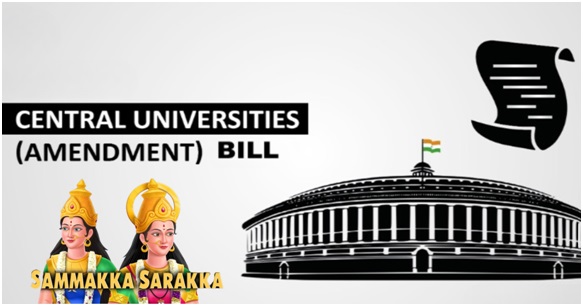Central Universities (Amendment) Bill, 2023 and the Legend of Sammakka and Sarakka (NewsOnAir)

- 06 Dec 2023
Why is it in the News?
The Lok Sabha on Wednesday (6th December 2023) took up the Central Universities (Amendment) Bill, 2023 for consideration and passing. The Bill amends the Central Universities Act, 2009, which establishes central universities for teaching and research in various states.
News Summary:
- Recently, the Lok Sabha took up the Central Universities (Amendment) Bill, 2023 for consideration and passing.
- The Bill amends the Central Universities Act, 2009, which establishes central universities for teaching and research in various states.
- The Bill seeks to establish a Central Tribal University in Telangana which will be named ‘Sammakka Sarakka Central Tribal University’.
Background:
- This legislative proposal aligns with the commitments outlined in the Andhra Pradesh Reorganisation Act, 2014.
- The 2014 Reorganisation Act resulted in the division of the former state of Andhra Pradesh into Telangana and the remaining Andhra Pradesh state.
- As per this act, both Andhra Pradesh and Telangana were promised support to establish a tribal university each.
Key Features:
- Amendment to Central Universities Act, 2009: The bill involves amendments to the Central Universities Act, 2009, a legislation enacted to establish and incorporate universities dedicated to teaching and research across various states.
- Name of the Central Tribal University: The university is named as a tribute to the legendary mother-daughter duo, Sammakka and Sarakka.
- Addressing Regional Aspirations: The establishment of the Sammakka Sarakka Central Tribal University is poised to address and fulfil regional aspirations for the foreseeable future.
- Focus on Tribal Population: The university's primary objective is to offer avenues for higher education and research facilities, with a special emphasis on serving the tribal population of India.
About the Legend of Sammakka and Sarakka:
- As per the legends, Sammakka was married to a feudal chief of the Kakatiyas dynasty, Pagididda Raju who ruled over the Warangal region.
- She had two daughters and one son - Sarakka or Saralamma, Nagulamma and Jampanna, respectively.
- In the 13th century, Saralamma succumbed in a battle against local rulers protesting tax imposition, while Sammakka vanished into the hills.
- The local (Koya) tribals believed she transformed into a vermillion casket.
The Sammakka Saralamma Jatara:
- The Sammakka Sarakka Jathara, also known as Medaram Jathara, is a biennial festival that commemorates the 13th-century battle where the mother-daughter duo actively protested against local rulers imposing taxes on the Koya tribe.
- Sammakka and Sarakka are revered as protectors of the Koya tribe, and the festival is distinctively free from Vedic or Brahmanic influences.
- During the festival, devotees take a holy dip in Jampanna Vagu, a stream and tributary of the River Godavari.
- Commencing from Medaram, situated in the Eturnagaram Wildlife Sanctuary within the Dandakaranya forest, the Jathara involves Koya tribe priests performing rituals.
- Various tribal and non-tribal communities from Andhra Pradesh, Madhya Pradesh, Chhattisgarh, Odisha, Maharashtra, Karnataka, and Jharkhand actively participated in the event.
- Recognized as the second-largest fair in India and often likened to the Kumbh Mela for tribals, the festival holds the status of a state festival declared by the Telangana government.
Political and Cultural Significance of the Sammakka Saralamma Jatara:
- The festival attracts participation from the Union Ministry of Tribal Affairs and the Telangana state government, including the Chief Minister.
- Funding has been released for community shelters and infrastructure, and the Ministry of Tourism allocated Rs. 75.88 crore for the integrated development of a tribal circuit under the Swadesh Darshan Scheme.
- This circuit encompasses Mulugu, Laknavaram, Medavaram, Tadvai, Damaravi, Mallur, and Bogatha Waterfalls, where the Sammakka-Sarakka temple is located.
- Mulugu, a reserved Scheduled Tribes (ST) assembly seat with a population of approximately 2.6 lakhs (2011 Census), holds political and cultural significance with a 75% ST population.
- The UNESCO World Heritage Site of Ramappa Temple is situated about 15 km from Mulugu.
Koya Tribe
- The Koya tribe, recognized as the largest Adivasi tribe in Telangana, holds Scheduled Tribe status in the region.
- They are dispersed across the Telugu-speaking states of Telangana and Andhra Pradesh.
- The Koyas commonly refer to themselves as Dorala Sattam (Lords group) and Putta Dora (original lords).
- In their dialect, akin to Gonds, they identify as "Koitur."
- Habitat and Livelihood: The Godavari and Sabari rivers, integral to their habitat, significantly shape the economic, social, and cultural aspects of Koya life.
- Primarily settled cultivators, they engage in the cultivation of crops like Jowar, Ragi, Bajra, and various millets.
- Language: While some Koya individuals have adopted Telugu as their primary language, others in different regions still speak the Koya dialect.
- Religion and Festivals: Key deities in Koya religious practices include Lord Bhima, Korra Rajulu, Mamili, and Potaraju.
- Major festivals for the Koyas include Vijji Pandum (seeds charming festival) and Kondala Kolupu (festival to appease Hill deities).
- Cultural Practices: During festivals and marriage ceremonies, the Koyas showcase a vibrant and robust dance known as Permakok ata (Bison horn dance).
